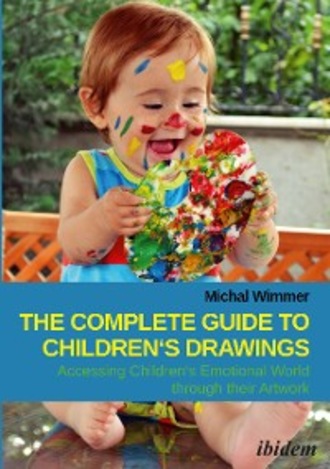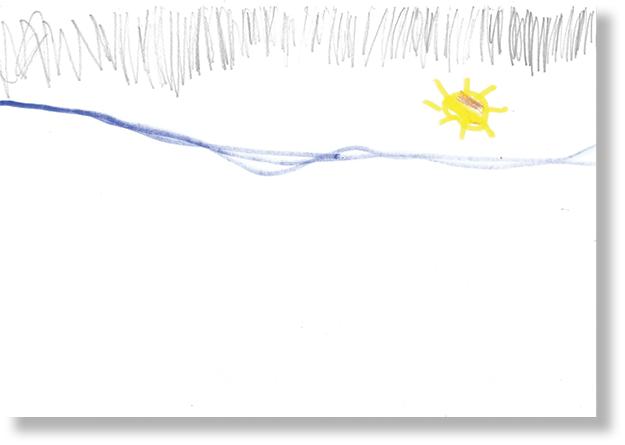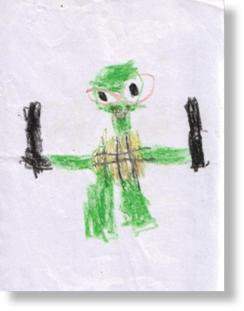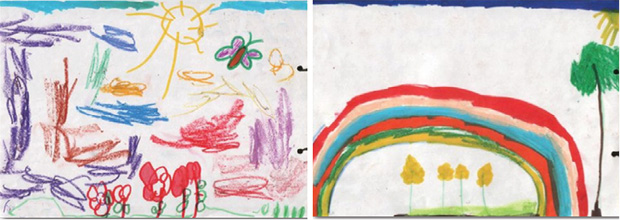
Полная версия
The Complete Guide to Children's Drawings: Accessing Children‘s Emotional World through their Artwork
Indeed, one of the first studies in this area (Goodenough 1926) found significant gender differences in human figure drawings. Boys tend to draw figures in profile with long, dominant limbs, while girls draw small palms and feet. Goodenough attributed these differences to society’s tendency to emphasize girls’ appearance and encourage boys to be more physically active, a tendency that has changed considerably since her studies.
Physiological differences and differential tendencies to have certain disabilities are central to assessing gender differences in drawings. For example, the dominance of their right hemisphere, combined with other physiological factors, mean that learning disabilities are more common among boys. Thus, many cases of refusal to draw or difficulties in drawing and writing are later discovered to be related to dysgraphia or another disability. Particularly in the disabilities area, however, it is very important to avoid jumping into conclusions and test the child’s skills using other diagnostic methods, in addition to drawings.

Figure 1-32:A typically “boyish” drawing
This right hemispheric dominance also means that boys have better spatial perception. They study mazes and love drawing maps and diagrams. They also love drawing vehicles such as airplanes, tanks and cars. The following drawing by a 12½ year-old is a typically “boyish” drawing that emphasizes structure and space, as well as demonstrating considerable effort to reach the required level of accuracy.
To conclude, the objective in interpreting boys’ versus girls’ drawings is not to arrive at generalized conclusions supporting statistical findings about gender differences, but to identify differences that simply mean that the child in question is a typical boy or girl. Children of both genders have always experimented with gender atypical behaviors, a phenomenon that seems to be more acceptable nowadays. When interpreting children’s drawings, you must be keenly aware of such social developments.
Copying
A group of children is seated around the table and everyone is busy drawing. A pair of inquisitive eyes checks neighboring drawings and sees that one girl drew a sun, while one boy drew a red car. The eyes return to their own page and want to draw like that as well. When our children return from kindergarten with a stack of drawings held in their little hands, how can we know which are really their own? Did somebody help them out? Did they copy from others?
Copying is prevalent since early age. Learning by observation is the basic way of acquiring language, for example, and indeed adults also tend to imitate others’ speak, clothing, style and even opinions and ideologies. Given these universal truths, you need to ask, what made the child copy? Is the final product exactly identical to the source or has it been adjusted in some way? Finally, did copying help the child improve his drawing skills and enable him to continue on his own, at a higher level?
Copying has many positive aspects. First, it means the child is aware of his environment. He is curious to learn from older and more experienced children – by studying their behavior he reaches conclusions that are relevant to his future behavior. Second, copying introduces the child to peer society – now he’s just like all the boys (girls): everyone draws spaceships (mermaids) and now he does as well. Copying is often a way of belonging and advancing socially. Clearly, the very act of observing other children’s behavior, regardless of whether it leads to copying, promotes the child as it exposes him to diverse approaches to the same issue and thus sharpens his social perception.


There are other reasons for copying and imitating, however. Western culture encourages children to develop quickly and be achievers. Children who lag behind will obviously notice this and may copy out of fear of seeming less intelligent. This trend continues and even intensifies during the school years: the fact that all classmates study together and receive grades for the same assignments encourages many children to constantly compare themselves to others, and even copy from them. Observing a variety of drawings by the same child enables experts to identify atypical, “fake” elements. For example, you would find figures or styles that are age appropriate, but rendered in a rigid and stereotypical manner, with no personal touch. By the way, the pressure to perform does not always originate at kindergarten. It is often the parents who insist on teaching the preschooler math and English in order to turn him into a genius that pressure the child, or older siblings whose achievements are a source of envy. In such cases as well, when the atmosphere at home is so demanding, children are liable to copy for the wrong reasons. Remember always that even when children copy from others, their natural human tendency is to leave their own mark, so that the copying child changes the drawing and eventually produces a unique work of art.
7 tips on how to respond to children’s drawing:
•Look at his drawing when you are available for it
•State clearly what you can see in the drawing
•Ask him if he wants to explain his drawing and respect his answer
•Try not to give him remarks on “mistakes” in his drawing
•Avoid overwhelming him with questions so as not to pressure him
•When you give compliments, do it fairly and meaningfully
•Encourage his creativity rather than the final outcome
2 Colors
Introduction
In 1777 the German philosopher Goethe climbed Mount Brocken in the Harz Mountains, where he noticed how the color shades changed on the snow: “Over the yellowish background of the snow, the shadows looked purple… while during sunset, everything around was filled with magnificent magenta and the shadows became beautifully green. Later on, following the sunset, the magical harmony vanished, replaced by a gray starry night”. The sunset which Goethe describes appears in countless other songs, stories, legends and drawings and one cannot remain indifferent to its powerful color combinations.
Colors and Science
Scientifically, colors were studied in terms of wavelength and frequency. It appears that the order of colors in the spectrum matches wave characteristics. For example, the color red which appears at one end of the spectrum has the longest (visible) wavelength and the lowest frequency. Purple, on the other hand, appears at the other end of the spectrum, with the shortest wavelength and highest. These characteristics, discussed in depth later on, affect children’s energy levels, as can be observed in their drawings.
Colors have also been studied from a physiological perspective, and it was found that they have a clear effect on our bodies (Fisher & Zelanski, 2009). Adding the clear physiological relationship between colors and our body to the mind-self relationship explains why children who are exposed to a certain color project it from their inner world to the outside by behaving in a certain manner. It is no coincident that we relax when we look at green mountains or blue oceans, and yet become more aroused when we see red. These insights are used for marketing purposes, but can also be relevant to our effort to understand our children’s world through their drawings.
When you compare children’s drawings to their personality traits, you see a significant relationship between them. Years of research have proven to us that using a certain color or color combination may project on emotional meanings that will be detailed further on. However, what is the reason for the strong influence colors have on our lives and drawings?
Observing nature and our long evolution process may provide the answer to this question. In prehistory, and in fact almost throughout human history, people were busy raising crops, domesticating animals and barter trading. These activities often included spending long hours outside, close to nature. As a result, people have developed various insights regarding nature and the way it operates.
These insights were subsequently used for survival or comfort. Their intensive contact with nature also caused our forefathers to unconsciously internalize the meanings of colors – they understood that green meant growth, new beginnings and abundance, brown meant a solid ground, black meant danger, and blue meant that the rain had stopped and they could resume work, and so on.
Analysis of children’s drawings and the meanings of colors used in them will show striking resemblance to our forefathers’ perception of colors. In other words, current color perception is a product of human cultural evolution. So, similarly to our instinctual perception of snakes as dangerous, we see in yellow (sunlight) as a source of joy.
This idea is reinforced by other phenomena in children’s drawing, which also show a connection between physical and mental aspects of decisions children make while drawing. Two such examples are the stages of development in drawings and the way objects such as houses are drawn in various cultures. In these cases, studies clearly show that children from all over the world follow the same general artistic path, most probably dictated by our inborn perception and collective unconscious.
Colors and Psychology
Colors form a universal language. Psychological theories, like Jung’s, about the meanings of signs, concluded that signs in dreams, stories and drawings are part of our collective unconscious. Accordingly, colors were also shown to have collective meanings. This means that even if a certain color has a specific meaning in a certain culture and different meanings in others, the internal, profoundly symbolic influence on individual choices will nevertheless be homogenous and universal.
The first psychological studies of the emotional meanings of colors were conducted by Goethe. In 1810, he began attributing positive significance to warm colors and negative significance to cold colors. He was followed by artists such as Kandisnsky and psychologists who studied color preferences at kindergarten age, among schoolchildren, among adults and among children hospitalized for cancer.
Colors in the Child’s World
Colors fascinate children ever since they are a few months old. The cerebral cortex is responsible for the complex interpretation of sensory input, enabling children to identify and name certain colors. When babies develop eyesight, they are able to distinguish between dark and light colors and show greater interest in shiny colorful toys. Later on, they will develop the ability to differentiate shapes and patterns.
Colors arouse various feelings among children – for example, some will like red, but others will hate it because it reminds them of medicine. Some colors rouse children to action, others calm them down, and still others will cause disquiet and stress. Similarly, it seems the choice of colors in the child’s bedroom affects his mood and general functioning.
Most children enjoy using colors in their drawings. The exposure to colors develops their sensory mechanisms, so that the sense of sight integrates with the sense of touch, improving the child’s perception and functioning.
However, some children are color blind. These children process colors differently, and find it particularly difficult to distinguish between red and green and between blue and yellow. The problem is usually diagnosed around ages 4–5, after the children have acquired the ability to name colors. In the case of color blind children, no personality conclusions may be drawn based exclusively on the colors in their drawings; other elements and graphic indicators must be used instead.

Figure 2-1:Using color simply to depict reality
The key to diagnosing through colors is to look beyond the drawing. That is, ignore the drawing’s structure and elements such as house or tree, and focus on the dominant color. Nevertheless, you must beware of attributing far-reaching personality or behavioral meanings to the colors without cross-checking additional indicators. For example, the color green in figure 2-1 must not be ascribed emotional meanings because the use of green in this case is natural when drawing the ninja turtle figure.
In addition to the cross-checking of additional indicators in a child’s drawing, another important prerequisite is the amount of drawings analyzed – 25–30 will provide a good basis for a comprehensive analysis. If you observe recurring and dominant use of the same color in many of the child’s drawings, you may reach conclusions about his personality and difficulties based on the meaning of this color.
Furthermore, when you see a dominant color in the child’s drawings check with his parents whether this color was the only color available for drawing at the time. If the child had no other alternative, I don’t recommend reaching any conclusion about his inner world based on the meaning of colors.
This explains the meaning of colors in children’s drawings and their relationship with various personality traits. The choice or overuse of a certain color can help us arrive at conclusions about the child’s life.
In the following review of the various colors used in children’s drawings, I offer various examples of overuse. On the other hand, the two drawings below are examples for balanced color use. When color use is balanced as opposed to imbalanced, the emotional meanings detected through the colors will tend to be positive. Nevertheless, such tendencies alone cannot support emotional conclusions unless backed by other graphic indicators.

Figures 2-2 & 2-3: Examples for balanced use of colors in different ages
Red
This is one of children’s favorite colors. In fact, in most cases, it is the first color which comes to our mind when discussing colors. Because of its dominancy and attractiveness, you may find it in traffic lights and life-saving vehicles, but also in fast food restaurants. As red refers to guilt and sin, you may see examples of it in fairy tales like Little Red Riding Hood, who paid a heavy price for her “red” curiosity.
In history, red was used as a symbol of courage and bravery; hence it was included, even in ancient Rome, in warfare-related objects. In ancient Egypt, people used to paint their body red to demonstrate their power. In India, red symbolized lust for power and materialism.
In China, red has a positive connotation and is a symbol of luck. Therefore it is used in celebrations and wedding ceremonies, where brides traditionally wear red dresses. In addition, the ceremony in which a newborn is named is called Red Egg.
Red has a stimulating effect on our nervous system and exposure to it increases the breathing rate and blood pressure (Ritberger, 2009). This is why red is associated with aggressiveness and competition.
In nature, it was found that red causes seagull nestlings to excessively search for food. It was also found that among European robins red triggers aggressive behavior.
Red has other meanings in our life, such as the power of life and inner energy, as well as survival. Max Lüscher – Inventor of the Lüscher Color Test – referred to red as symbolic of activity and leadership, as well as life’s pleasures and success motivation. Goethe referred to red as a noble and graceful color, which symbolizes monarchy and sanctity, but when used in an exaggerated proportion might cause anxiety. Kandinsky agreed with him and thought of red as a color which is in constant movement and therefore causes restlessness.
Following its historic and cultural meanings, in children’s drawings red is considered dominant and impressive. It is related to activity and doing. Children who constantly use red are often characterized as dominant and extrovert. These children like to be at the center of social attention. They like competition and challenges and prefer, of course, to be the winners. They are willing to invest great effort and energy to become leaders. Socially, they are direct and willful, so they know how to get what they need, without giving up to other children. Excessive use of red is common among aggressive children.
In the following drawing, it is possible to see excessive use of red. The girl who made this drawing did not try to document reality, but preferred red over other colors.
Note that when observing colors in drawings I recommend focusing on the amounts of color used, in order to differentiate between balanced and exaggerated amounts of color.

Figure 2-4:Excessive use of red
In general, when the color is used in a reasonable and balanced way, you may tentatively conclude that the child’s is balanced with positive “red meanings” such as active, enthusiastic and having a strong desire to be in the social center. However, when the page is swamped with red, my tentative conclusion would be that the child is attempting to compensate for contents and traits he lacked. Warmth will be replaced by aggression, hastiness by disquiet and the desire to be in the center by an existential need to be popular.
In this case, when the child is not at the center of attention, she behaves as if exposed to an existential threat, and reacts with nervousness and temper tantrums. All this may be concluded from her overuse of red. Nevertheless, as mentioned above, you must cross-check the information gleaned through colors with other graphic indicators in the child’s drawings. Some such indicators are pressure, line drawing style, subject, and figure drawing style. These indicators will help you make a comprehensive and quality analysis of the child’s drawings and determine whether the use of specific color is balanced or exaggerated.
Orange
Kandinsky liked the power of orange – the combination of red and yellow represented, in his opinion, balanced emotions and closeness between people, each remaining aware of his own powers. Like red, orange belongs to the warm color family and as such symbolizes energy, enthusiasm and doing. Children attracted to this color tend to be creative and optimistic. They are willing to dare and join new adventures, out of curiosity and a desire to experience independently and achieve their goals. A child who likes to draw with orange does not obey rules easily, but demands explanations for most requests. He often exhausts his parents with long verbal discussions, in which he usually prevails.

Figure 2-5:Excessive use of orange
Nevertheless, the combination of yellow and red which produces orange somewhat moderates the emotional meanings we associate with red. Thus, children who use this color in an exaggerated way will be assertive rather than aggressive, enthusiastic rather than overeager, etc. When orange is used too intensively, it means the child sees pragmatism and creativity as important elements in his existence. Note that as a rule, orange stands for quality and represents ambition, health and also good communication with the environment, even at high doses.
Yellow
Similarly to red, yellow also symbolize caution and thus appears in many warning signs. Yellow is traditionally associated with jaundice and cowardice, as well as with aging, for both people and objects. In ancient Egypt it was used to mark criminals’ and traitors’ doors. In the Middle Ages, yellow costumes were used as the sign of the dead. In India yellow robes are often worn by Hindu swamis and Buddhist monks in their schools and during the spring festival. In Russia, yellow represents romantic breakup. Finally, we all remember Dorothy’s Yellow Brick Road.
For Lüscher, yellow is a sign of lightheartedness, joy and comfort, which are felt after escape from restricted situations. Moreover, it symbolizes diligence which is not stable or consistent. Often, yellow symbolizes a conflict one must resolve. In the positive aspect, it represents a child’s ambition with the ability to manage others in order to reach his goals.
Goethe observed that yellow is a complex color and noted that although in its basis yellow is a peaceful and joyful color, which gives a sense of warmth, when it becomes soiled, it gives a sense of nausea and discomfort. Kandinsky referred to yellow as an earthly color without any depth, which gives a feeling of restlessness, anger and jealousy.
When children use yellow in their drawings, it represents sensitivity. These children are well aware of their surrounding and deeply influenced by it. They are characterized by cleverness and patience, as well as joyfulness and mischief, but tend not to be troublemakers like children who use red. In addition, they are connected to their family and do not need many friends to find interest, because they have a rich inner world. They are also characterized by high concentration ability and a desire to experience, while taking the right precautions.
Exaggerated use of yellow represents oversensitivity which makes it difficult for the children to manage outside the inner circle of their loving family. When the child swamps the page with yellow, this also connotes naivety, innocence and empathy with other people’s pain.

Figure 2-6:Excessive use of yellow
This drawing was made by a 5½ year-old girl who desperately needs family closeness. Her family relocated to a new dwelling and she was about to enter first grade in a new school, without any of her old friends. As a result, this period was characterized by dependence, sensitivity and a strong need for support and reinforcements.
Pink
As expected, pink is most commonly used by girls. At a certain age this color dominates their world and they dress in pink clothes, play with pink toys, sleep on pink sheets and dream pink dreams. Although some boys also show interest in this color and add pink to their drawings, this color is commonly identified with femininity. Women who are attracted to stereotypically feminine jobs, and who adopt behaviors considered feminine, such as makeup, body care and fashion, tend to use it.
Many parents look at their girl when she is at this pink stage, smile and say that she is a little lady. This girl imitates dress codes of older women, but does it in an extreme and grotesque way, so some parents cannot bear it anymore. Beside her obsession with her appearance, she also adopts the mannerisms of older women, giving orders and bossing other children. Often she would find a boy who will be willing to kowtow to her every whim.
In children’s drawings, pink refers to pleasing. Such behavior is common and normal at ages 5–7, but at older ages, a child who uses pink excessively may be characterized as having a strong need to please others, willfulness and a sense of esthetics.
Blue
Unlike pink, which is associated with femininity, blue is associated with masculinity. Blue is also associated with royalty and divinity. In ancient Egypt blue symbolized protection against evil, with the Pharaohs wearing blue clothes. In India, blue symbolizes the creation of the universe and divine wisdom, and the Buddha’s body is often painted blue.



